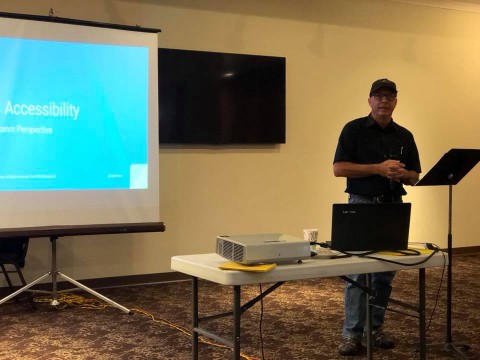Make Your Digital Content More Accessible

Are your website and digital documents accessible to people with diverse abilities? Is your online content able to be read or followed by those with visual, auditory, dexterity and cognitive impairments?
At the FPRA Pensacola Chapter June meeting, Jay Massey, chief vision officer with Coco Interactive, LLC, shared his insights, experiences and helpful tips at how marketing and PR professionals can be more accessible with their digital content. Providing accessibility is not only the right thing to do, it is also vital for brand recognition, community perception, sales, marketing, crisis communication, and legal and regulatory compliance.
Massey expressed the need for each business owner, company or organization to have at least a basic accessibility statement be visible on digital platforms, such as a website. The accessibility statement should include the following:
- Company’s name followed by details on the company’s commitment to facilitating accessibility and usability of the website (or other digital platform)
- Share the plan that says how the company/business has or is accomplishing its accessibility, such as:
- We implement or update features over time to increase the accessibility of our website for users with disabilities based on the guidelines of W3C Web Accessibility Initiative (WAI).
- Our company’s website is tested on a regular basis using assistive technology like screen readers and magnifiers by users with disabilities who use these services. (Please note that this is optional and optimal but not required yet across the industry board.)
- Our company employees staff, contracts persons or uses tools to assess our website’s accessibility and provides feedback and recommendations to keep website current and accessible.
- Contact information (name, department) of person(s) responsible for accessibility if any concerns or questions arise
- Date that the company adopted and/or updated the policy or statement for accessibility. Please note that a policy and statement are different based on the organization, like a university.
If your business or organization is just starting the process of accessibility, it can be overwhelming. Massey encouraged tackling one thing at a time if needed, but continuously working toward advancement and improvements. “If you can’t fix a problem right away, then make an accommodation,” Massey said. “Going forward think about the whole picture and it will be easier to maintain.”
A few basic smarter accessibility tips for designers and creative web developers include:
- Having the right contrast in design. Ensure that the colors will be beneficial to those with impairments or those devices reading/sending information to people with disabilities.
- Avoid overriding font styles or calling out colors like red and green in text.
- Whenever possible, avoid directional text and terms on websites. Don’t use words like “Click here,” “Below here,” “Read more,” “Follow this link” and other similar terms that are not helpful to visually impaired and others with disabilities. Instead just use targeted call-to-action text and captions on what you want the reader to do.
- Avoid using timed out sessions that could be a barrier to a person, especially when completing a form or application online.
- Recruit the help of sources to monitor and improve your website’s accessibility (Examples mentioned were WebAIM’s free WAVE tool, or the paid SaaS tool Siteimprove).
Elegant simplicity is vital according to Jay. Websites and digital content can be beautiful and accessible for all if thoughtfully well designed.
Thank you to Jay for sharing this important topic. Did you attend the meeting and gain another takeaway worth sharing? Will you implement any of these strategies in your company’s website? Share with us what you found useful and will be doing. Join us for our next FPRA meeting on July 19 and find your #PurposeInPR. Don’t forget to register for the FPRA 80th Annual Conference and learn best practices and PR tips you can use now.